Last Year’s Finds and their Finders – Jude Jones
Jude Jones, our Finds Specialist, has written this fantastic post about the finds of 2013 and their finders.
Thanks Jude!
Last Year’s Finds and their Finders
On first viewing the Bothy, I said to Gareth and Nicole Beale, our University of Southampton site directors, that one of the things a finds co-ordinator gets really excited about is a good finds hut. We’re supremely blessed at Basing House with the Bothy which is, in effect, a small cottage with its own back garden. Inside it’s equipped with electricity, running water, kettles and not one but two fridges! This is fantastic compared with the usual leaky finds tent set in the middle of a field with no water sources to be found for miles. Here at Basing we can wash, clean and dry finds prior to their analysis and the Bothy allows us to set up spot-lighting, cameras, microscopes, laptops and all the other paraphernalia of a proper lab so that we can even do a little post-excavation work on them before the season ends – luxury!
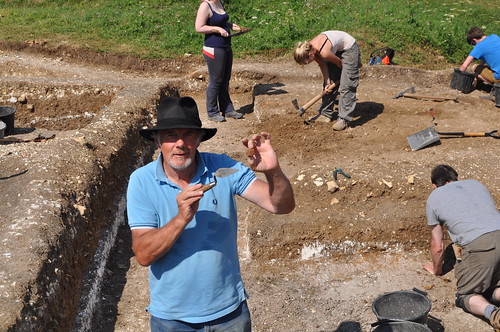
Dave Allen showing a freshly dug Roman tesserae, shortly on its way to Jude and her team at the Finds Hut.
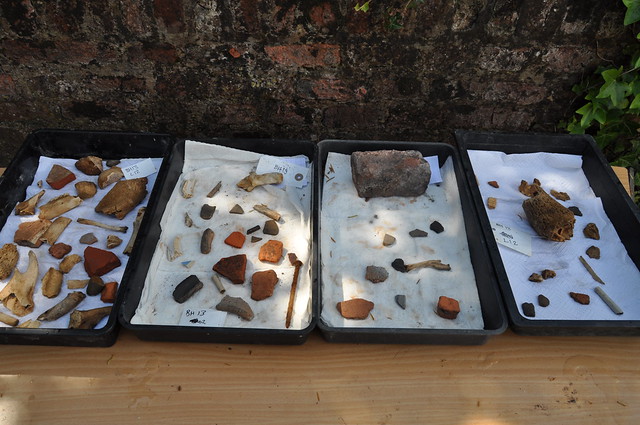
Finds drying in the sunshine after gentle washing by Jude and her team.
Last year was the Southampton contingent’s first encounter with the site and our archaeology students worked side by side, not only with members of staff from our department, Dr Yvonne Marshall, Christina Triantafillou and Penny Copeland but also with several members of the Basing House Archaeological and Historical Society whose previous experience both at Basing House and elsewhere proved invaluable. For many of the first year students who had not excavated before, the first week was rather back-breaking as they were digging through the infilled spoil of a series of 1963-4 box trenches in order to review the archaeology and get a better idea of the Roman and Iron Age occupation the 1960s seasons had found.

Jude looking at a Roman coin with Lizzie.
Finds from the spoil were accordingly either residual or evidence of much more recent activity. We started to get quite excited when a few sherds of what seemed to be a 17th century slip-ware mug appeared amongst the Carling Black Label cans and Fanta bottles but the freshness of the sherds, their lack of abrasion and a sober assessment by Dave Allen, our third director and the Hampshire Museum Services Keeper of Archaeology, that the mug was not what it seemed soon dispelled any illusions. The Sealed Knot – the well-known Civil War re-enactment society – had been frequent visitors to Basing House in the past and their passion for recreating all things 17th century was likely to be the cause of this mug’s appearance amidst the rest of the 20th century litter.
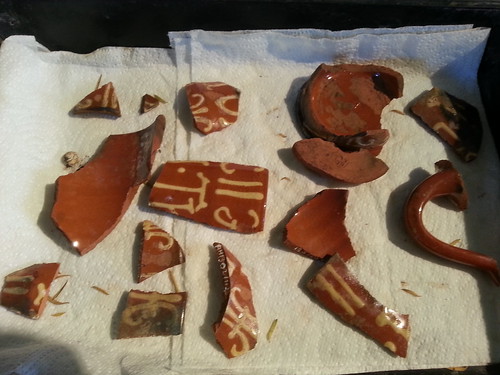
Upon cleaning it was apparent that this ‘slipware mug’ was not what we have originally hoped!
A latter day Royalist or Parliamentarian had broken their mug and thrown it into the insufficiently filled-in hole left after the 1960s diggers had packed up and gone home. This was confirmed soon after when the rest of the mug surfaced and a potter’s mark was discovered on its base. Alan Turton, Dave’s colleague, Civil War expert and the retired director of Basing House was visiting at the time. ‘Ah,’ he said to Dave, on being shown it, ‘Spike made that!’ Their friend Spike, a member of the Sealed Knot and a professional potter, specialised in selling replicas of 17th century slipware vessels and this was undoubtedly one of them.
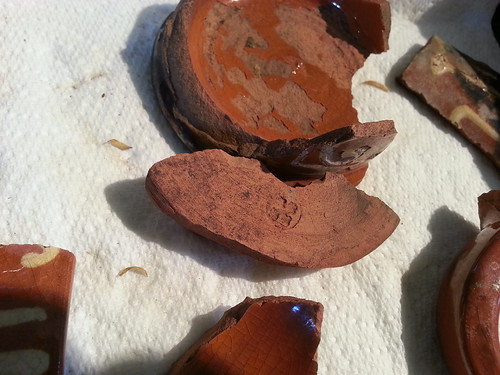
Spike’s stamp can be seen in the very centre of this image.
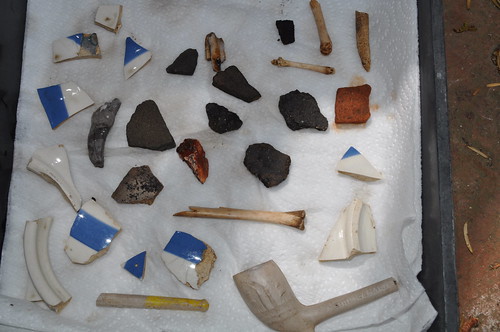
Nearly all of the finds drying in this tray are modern replicas of artefacts. In this context, there was a modern blue and white china teapot mixed up with a ‘Victorian’ pipe and some ‘Roman’ tile.
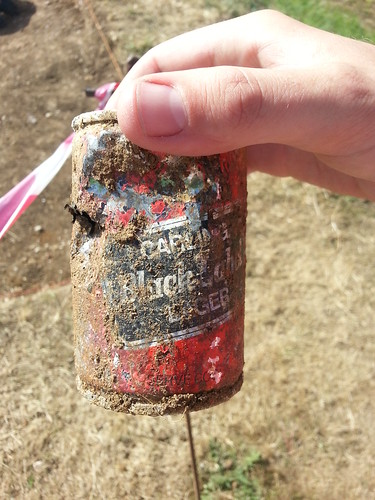
Carling Black Label can from the 1980s. Even very modern finds can tell us about the history of a site!
Oddly enough, this story helped to bring home to us the reality of the past. Just as many archaeologists get a thrill when they dig up something which no one has handled for centuries, so it evoked the continuing archaeology of the site. Three centuries and more after the Civil War sieges which had laid waste John Paulet’s magnificent great house the battles were still being remembered and restaged and those involved were likewise leaving behind the unwanted rubbish which signalled their presence and their passing. Memory is continually being reiterated and kept alive in this way through these small discarded fragments.
In spite of their great diagnostic, classificatory and historical use, initially finds can sometimes appear to be of somewhat subsidiary importance when a dig is in progress. Not unnaturally, excavators get caught up in the constant streams of analysis which trenches produce when exciting features appear. At this point, finds, especially things like pottery and coins, are used primarily as dating indicators. This changes as soon as they get back to the finds hut. Here even the simple act of cleaning a find can suddenly awaken an intense interest in deciphering the puzzle of what it is and how it fits into the site’s archaeology.
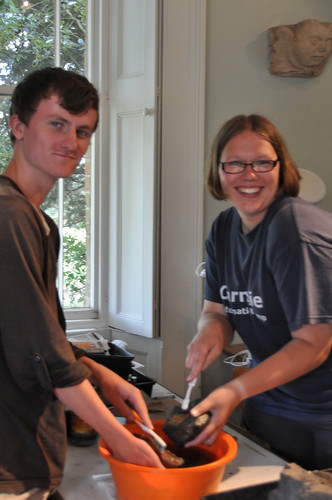
Ed and Alina clean finds under Jude’s supervision.

Miriam, cleaning and marking a tile sherd.
In 2013 we were fortunate to have contingents of students and volunteers, all of whom were happy to be inducted into the mysteries of finds processing and recording and were later introduced to some of the post-excavation techniques which we were able to apply as a result of the Bothy’s facilities.
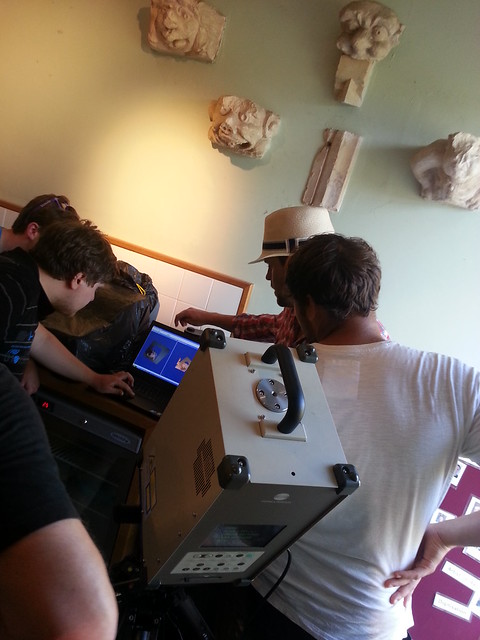
Gareth working with students to laser scan the corbels in the Bothy (Finds Hut).
Nicole and Gareth set up the equipment necessary to carry out Reflectance Transformation Imaging (RTI) – a photographic process which allows a near microscopic and all-round directional analysis of the surfaces of finds. At this point an object’s minutest details, its use-wear, construction, tools marks etc instantly become visible from all sides. We used it to study the surfaces of the five Roman coins we found towards the end of the dig and as a result several students were enthralled by its possibilities. One of them, Vicky Man, may even use it as a central research tool for her undergraduate dissertation. Phoebe has written about the RTI of one of the coins here: http://basinghouseproject.org/2013/08/05/day-10-coin-phoebe/

Jude carefully cleaning one of the Roman coins, ready for RTI recording.

RTI of one of the Roman coins. Can you read it?
We were also lucky enough to be given a post-excavation conservation workshop by Claire Woodhead of Hampshire Museum Services Conservation Laboratory. This continued the story of what happens to finds once they are subjected to the more complex scientific analyses which reveal their significance. Claire’s accounts of the various proceedings which are applied to the many different categories of finds were crucially instrumental in completing our overview and experience of the finds process from A-Z.
Lastly, a small boast and a profound vote of thanks to Alice Millard: we very nearly managed to put the entire collection of finds on to a database by the end of the dig!

Vicky and Alice RTIing a coin.
Alice, a dab hand with laptop and finds bag, soldiered womanfully on in our last week and entered practically all the objects, washed, dried, studied, labelled, bagged, described and categorised – no mean feat and a task which is usually left to the weeks after a season has finished. My heartfelt thanks also go to all the students and volunteers who assisted me in undertaking all of the above activities and helped to make the Bothy such a cheerful place – even when invaded by swarms of thirsty diggers requiring tea and coffee and demanding to know who had eaten all the biscuits!
– Jude Jones
For more detailed info on the finds themselves see the Interim Report 2013, which will be online here very soon.
Filed under: Archaeology of Archaeology, Finds, Interim Report 2013, Jude Jones, Summer Excavation Tagged: 1960s, Alan Turton, biscuits, Bothy, box trenches, coin, conservation, English Civil War Society, finds, Iron Age, mug, parliamentarian, paulet, roman, royalist, rti, rubbish, Sealed Knot, sieges, slip-ware, spoil, tool marks, use-wear
